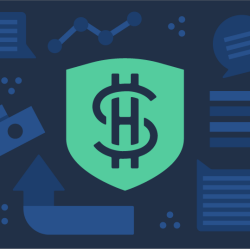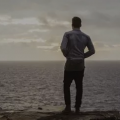9 Life Lessons from Starting a Daily Podcast
So hey—I started a podcast! Yes, it’s true: I’m catching up to the technological age of 2005.
And let me tell you: I’m having so much fun. I feel purposeful.
Readers—many of whom are now listeners—are really enjoying it. And best of all, I truly believe it’s going to be helpful to people.
So that’s great! There really is no downside. I’m glad I did this.
But what have I learned? That’s what this 6,500 word post is about. I’ll share my own lessons and observations, as well as my early advice for anyone thinking of starting their own podcast.

1. First, it takes a *LOT* of time to make a daily 10-minute show.
On average I’d say each episode takes me 3 hours from my side to script and record each draft of the show. Then it goes to a production team in Brooklyn, and they do the audio editing and add the awesome music (thank you, DJ Jayson). They ask for recuts of certain parts, then we go back and forth on the files for a bit.
But that’s just the production! In addition to the most obvious part of making a podcast, I’ve easily spent at least another 2-3 hours a day working on the show since it’s started. That’s 7 days a week, regardless of what else is happening, and whether I’m at home in Portland or flying around the world like I am now while writing these notes.
We also built a website, meaning that I said “Hey, let’s build a website” and then people much smarter than me went to work. Even though I’m just the manager in this process, AKA the least-skilled person, there’s still a lot of ongoing maintenance and active attention required from me.
We have show notes for every episode (and we’re working on improving them), a daily email that goes out, a community forum in the works, a traveling workshop series that starts very soon, and … well, much more. I won’t bore you with a list because the work really should speak for itself.
When I think about the past three weeks, pretty much all I remember is waking up to work on something related to the show, then eventually going to sleep at night.
To be clear, I’m not complaining. I love doing this; I’d spend my time no other way and I’m happy to go all-in. I’m just saying: it takes a LOT of time.

2. Gretchen was right, Part 1: A podcast really does reach an all-new group of people!
This lesson comes from Gretchen Rubin, a longtime friend who also happens to be the head of Panoply’s new Onward imprint, which Side Hustle School is part of.
First, a quick side note: Gretchen is my hero! I’ve been following her since the blogging dinosaur age when I started The Art of Non-Conformity. Her site, along with one from another friend, J.D. Roth, were early inspirations for me. She is also the only author to have blurbed (written an endorsement for) all four of my books. The fact that I get to work regularly with her now makes me, well, happy.
As for the lesson, when she and I first began talking about the show back in summer 2016, she told me how starting her podcast had brought her a whole-new audience. People had told her that it would, but she was skeptical.
When she told me this story, she was very modest about it, so I’ll translate: her books have done extremely well. The Happiness Project, which I’m proud to own an original advance copy of, has sold millions of copies all over the world. It’s appeared in movies, celebrities regularly share photos of it, and it was on the New York Times list for a ridiculous number of weeks.
Then, she had another runaway bestseller with Better than Before, and she’s gearing up for another big book this fall based on her (also very popular) Four Tendencies quiz. According to the quiz, and to Gretchen herself, I’m a rebel. Shocking, I know! She and I talked about it in this episode of Happier.

Gretchen being interviewed by Oprah Winfrey on her show
The point is that Gretchen had very high name recognition before beginning her show, yet the show brought her another highly-committed and engaged audience. It had a magnifying effect that has allowed her to continue to stay at the top despite great saturation in a field she was a big part of pioneering.
So now back to me: except for the part about very high name recognition—since no one can spell or pronounce my name—and except for those millions of copies sold (I’m approaching my first million, but she will always be ahead…), I’m seeing very much the same effect.
Upwards of 150 people a day are joining the daily email list for the show. I notice a lot of social media comments from people I don’t recognize. I’m hearing from passive readers who are now active listeners. My requests for media quotes and commentary are way up.
All of that to say: if you’re thinking about starting a podcast, it really is a medium entirely of its own. And as a result, if you do it right, it really will attract a very different group of people.

3. Gretchen was right, Part 2: “A strong voice repels as well as attracts.”
In my early days with The Art of Non-Conformity, and then with The $100 Startup as well, I received a lot of criticism. I used to regularly get hateful emails from people who didn’t like what I had to say about one subject or another.
But in recent years, the criticism I’ve received has lessened in intensity and volume. Isn’t that great? Well, it’s good for the psyche, I suppose. Whoever said that criticism doesn’t bother them was definitely not a writer or artist.
But it also means that my message became a bit more mainstream over time, and that has pros and cons. The risk is that you have the potential of becoming irrelevant or even obscure, which is probably the worst thing that can happen if you’re trying to put forth a message.
With this show, I’m definitely drawing in a lot more people and a lot more commitment from at least some of those people. And I’m also drawing a lot more active dismissal and criticism than I’ve seen in a while.
And you know what? I think that’s great! Well, at least objectively speaking I think it’s great. I’ll always be a sensitive soul, but that’s where Gretchen’s comment comes in, via her podcasting manifesto: “A strong voice repels as well as attracts.”
When it comes to Side Hustle School, I wholeheartedly believe in the mission, both in terms of intent and approach. If someone hates it or just thinks it’s a waste of time (and there are already plenty of people who do), I’m honestly not that concerned about them.
Please don’t misunderstand: I’m not saying I’m right and they’re wrong.
I’m saying: I know where I’m going with this, and I know who it’s for.
It will be good for some people and not for others, and that’s okay with me. I am 100% committed to the show’s format, the daily practice, and the long-term vision.
4. If You Want to Start a Podcast, Take the Time to Prepare
First: is it worth it? Yes, as long as you have a plan.
It took me about five months of preparation, but not all of that time was active work. Some of it was thinking things through, researching different aspects of the endeavor, working with the partner who handles distribution and advertising, etc.
I probably worked at least two months full-time on it before the debut, but beyond that I’m not sure because as long as I’m working on things I believe in, I don’t really keep up with how I spend my time.
Here are a few things I did:
-Talked with John Lee Dumas and watched his “Podcasting Lessons” series.
First of all: super awesome guy! He regularly spoke with me on Skype and texted me advice and ideas.
Much of the podcast series I watched covered topics that were somewhat familiar to me, since I’ve been working online for all eternity more than twenty years. However, it was still very helpful in allowing me to reframe my thinking and approach to a new medium. It also confirmed to me that I was on the right track with what I was planning.

Note: Accomplish your #1 goal in 100 days with John’s Mastery Journal. The Kickstarter starts TODAY and I am making a pledge!
-Experimented in writing draft episodes four months in advance.
I scripted out at least five episodes and recorded them using various equipment (full list later on). I hired someone on Fiverr.com to create DRAFT intro and exit music. This cost a whopping $25 and is most definitely not something I’d do for the real thing, but as an experiment, it was very helpful.
Those first drafts sucked, of course. So did the second. Around the fourth or fifth attempt, maybe three or four weeks into the experimentation phase, I began to notice some potential for finding the right format and voice.
I wrote in a few different environments: Evernote, Google Docs, and Scrivener, the same software I use for writing books. I finally settled on Scrivener because it’s easy to work in multiple sections and move things around.
Like most of my other work, the files sync directly to Dropbox so I can work from any computer.

Sneak peak of my scripts in Scrivener

Sneak peak of my system!
-Began recruiting stories.
Since I knew I’d be teaching through storytelling, and since I wanted to do the show DAILY, I knew I’d need to work as far ahead as possible. I put the word out saying that I was looking for interesting candidates.
I did this directly on my site (the form now lives over here—please use that one if submitting) and also through HARO, a longstanding directory that connects journalists with sources. I only use that service once or twice a year, but whenever I do, I’ve been happy with the results.
Over time I began to see what kinds of stories would be good for the show. Quirky? Absolutely. Inspirational? Maybe, but not in a fluffy way—I wanted lots of details and specifics.
I also wanted a range of stories. First and foremost, I wanted them to be relatable. As I say often on the show, when you’ve never made money on your own before, it’s a Very Big Deal to start getting an extra $500-$1,000 a month that doesn’t come from your job.
But I also wanted them to be aspirational. Many hustles have the potential to make far more than $500 a month, and I regularly hear $100,000+ success stories.
So I decided to go with a mix: some would be about people making $500-1,000 a month in their hustle. Others would be about people making six-figures a year or more with their hustle. My hope was that the show could become both relatable and aspirational.
I also set some parameters about what a side hustle is. This phrase and concept is in the culture more and more these days, so I wanted to be specific about what I mean when I use it:
-
It’s not your full-time gig
-
You may want to turn your hustle into your full-time gig, but just as often, you may not want to
-
It’s not a part-time job; it’s something you have ownership over
Side note: Despite what their ads will tell you, DRIVING FOR UBER IS NOT A SIDE HUSTLE. We’ll save that rant for later because it deserves an editorial space of its own.
Oh, and one more thing: I wanted to avoid any sort of spammy or circular examples, where there isn’t any real value in what the hustler is making or doing. With that in mind, there are very few (if any) stories of people making money showing other people how to make money. Instead, there are stories of:
- A woman who hosts dogs in her home for up to $200 a day
- A man who earns $700/month from fish tank reviews he wrote 3 years ago
- “Saddles for Pet Chickens” (you just have to hear it, and don’t worry—there’s no fowl play)
- A teacher who develops curriculum for her colleagues
- Two guys who think about starting a distillery, but then create a “Homemade Gin Kit” that sells 75,000 units
Each story is intended to be interesting and educational. With a few exceptions, I’m trying to focus on classic lessons reframed in unusual case studies.
-Controversial opinion ahead! I did *NOT* listen to other podcasts while developing my own.
I’ll be honest about something that I’m sure some people will disagree with. There’s something NOT on this list that you’d probably expect there to be: I did not “listen to a lot of podcasts before beginning.”
Why not? Well, I’m sure there are best practices I can learn from, but I really did want to create something unique. And the more I worked on it, the clearer my vision became, and the less I felt like I wanted to draw on anyone else’s work, at least directly.
Here’s how I thought about it: as a nonfiction author, I mostly read fiction. I do read some non-fiction as well, but it’s very rare for me to read a modern “Business & Careers” book like Born for This or The $100 Startup. I want to write original books with my own voice, and therefore I’m careful of letting other, potentially similar voices into my writing head.
I’d also note that I’m very familiar with the other side of podcasts, having been a guest on hundreds of them over the years. So it’s not that I knew nothing at all about the concept of podcasting. It’s just that as I set out to create my own, I wanted to find my own way.

5. Good equipment is inexpensive, but there’s more to the process than just buying stuff.
I sometimes go to a local studio for call-in interviews, but I didn’t want to attempt that with this project. There’s just way too much recording to be done!
My work style is to draft multiple versions of each episode while I’m recording the episode. It’s a messy process that works for me because I know what I want, but it would be frustrating (for both me and an engineer) to do it that way in a recording booth. I’m also an introvert, and I needed space of my own to figure out this new medium without the pressure of other people listening in real-time.
Therefore, I set out to create a DIY solution for the recording side. My home recording setup cost less than $1,000, and here’s what I bought:
- Shure SM7B Vocal Dynamic Microphone
- Audiotechnica Broadcast Stereo Headset
- Behringer Direct Input Box
- Sennheiser HD 202 II Headphones (cheap, but functional) for playback and review

Shoutout to my dear friend Jonathan Fields, who talked me through this list and made recommendations along the way. Check out his wildly popular show, Good Life Project!
But here’s the thing: just because you can spend less than $1,000 (and probably less than $500, actually—part of my expenses involved trying different things before I found what worked best for me), that doesn’t mean that’s all you need.
There’s also the production side. This is no small thing!

For that, I’m grateful to Panoply, a large podcasting network and now my distribution and advertising partner. I began talking with their team last summer following an introduction from Gretchen, who was creating the Onward imprint that launched on January 1. It’s a business arrangement with revenue share on the advertising, which will hopefully be sustainable enough for multiple people to work on the show throughout the year.
Why did I work with a network? Well, for me it was a lot like publishing books. Sure, I could publish books on my own, but they wouldn’t be as good. Even as a non-conformist, I’m somewhat a traditionalist when it comes to books. Without a doubt, I know that my work has been made better through a detailed editorial and production process.
So too with podcasting: I was a complete beginner in this world, and I’m still actively learning every day. I didn’t assume that I knew everything, and I thought I could benefit from detailed knowledge and assistance from experts.
Panoply is clear that they’re in to win it, and they expect their shows to have minimum downloads of at least 20,000 per episode. Presumably many of their shows do much more than that. In joining their team I felt like I was playing above my level, and I liked that.
Remember this lesson for both podcasting and life: you never want to be the proverbial big fish in a small pond. It may feel good for a while, but you’ll always wonder what might have happened if you’d tried harder. Step up!
6. Don’t start a “Tell Me About Your Life” show. No really, don’t do it!
If you want to go down the well-trodden, life of quiet desperation, abandon-all-hope-ye-who-enter-here podcast path, start a show in which you interview people about their life and career. For best results, invite the same people that appear on everyone else’s shows, then ask the same generic questions of them.
Here are some kiss-of-death starter questions for your script:
- What inspires you?
- How did you get started?
- What’s your biggest failure?
- How do you handle fear?
- What advice would you give your younger self?
I assure you, anyone who’s ever given an interview will be very familiar with these questions.
OK, so really—don’t do this. Don’t start a generic “let’s talk about life” show. Step away from the ledge!
If you want to have interviews on your show, that’s totally fine, but design a framework for them that is at least somewhat unique. (Note: “How you became an entrepreneur” or “Interview authors about their new books” is not somewhat unique.) You will stand out so much more with a focused topic, and your guests will enjoy it more too.
If you think I’m complaining… well, OK, I actually am complaining a bit about this. Over the years I’ve done literally hundreds of podcast interviews where people ask me the same questions, starting with “So tell us a little about yourself.”
Here’s the thing: I try to give a good interview, but my life story isn’t going to change from podcast to podcast. As a result, I end up saying the same things and telling the same stories over and over. After a while it can have the effect of phoning it in—which is terrible, of course, and listeners deserve better—but again, the basic narrative of my life doesn’t evolve from any given Tuesday to Wednesday.
Therefore, if you want to ask interesting questions on your podcast… ask anything other than the usual ones!
Hat tip: of all the podcast interviews I’ve done, The Art of Charm requires the most intense preparatory work by far, and it makes for a show that stands tall above many competitors. When they invited me as a guest, they also sent more than a dozen detailed essay questions that I had to answer before we did the interview. Respect!

7. Have a CLEAR and SPECIFIC audience in mind.
Think about who is NOT part of the audience as much as who is. For my show, I am deliberately excluding people like me. If you’re “self-employed for life,” as I sometimes describe myself (or “unemployable,” another term I use), you’re not who I’m thinking of every day as I work on the show.
This doesn’t mean those people aren’t welcome—I’ve already had a bunch of notes from listeners who are like me but still like the show.

No, I just mean that as you make the show, you create the content and direct your attention to that audience. Everyone’s welcome, but you focus on your CLEAR and SPECIFIC audience.
For me I wanted to direct my attention toward employees who don’t want to quit their jobs but do want extra income.
This is an important distinction, because with Side Hustle School, I’m not teaching people to “be entrepreneurs.” I don’t think everyone should be an entrepreneur, but I do think everyone should learn to think entrepreneurially.
In many conversations with people over the past year, especially on my Born for This book tour, I began to realize what an interesting and largely untapped market this is. There are many resources for aspirational entrepreneurs who want to build a company. But there are surprisingly few for people who just want to create more security for themselves without rewriting the pattern of their entire life.

In Philidelphia, PA for the Born For This Tour
In some ways, I think some people with jobs even feel judged or shamed for not wanting to quit—which is of course ridiculous! For example, my parents are aerospace engineers who’ve spent most of their careers supporting NASA missions. I’m not entirely sure how these things work, but I’m assuming that if you want to be an astronaut, you can’t do that on a freelance basis.
The same holds true for people working in numerous noble professions: teaching, medicine, journalism, social work, etc. And even leaving aside the question of whether some work is more beneficial to society than others, the reality is that a lot of people thrive in more collaborative networks that only exist in companies and organizations.
So yeah, it turns out that not everyone should go straight out and quit their job to backpack in Thailand. Maybe in some ways I feel partially responsible for creating this dynamic, so now I’m partially responsible for correcting it. Who knows! I’ll ask my therapist about this sometime.
In any case, these are my people, the ones I thought about over and over when creating the show: You’re out there and you want to create something for yourself. You’re smart and can work hard. But you’re also busy, and you need some guidance so you don’t waste your time.
100% of my focus is on people who fit that description.
8. Have a hook! Make your show EASY to understand and explain.
The hook is not just for the sake of marketing—though it helps there too—but also for your own sake. Or at least, that’s how it is for me. I love the specificity of it.
My hook was:
- Side Hustle School will be short-format, with most episodes less than 10-minutes long. My intended audience doesn’t have time to listen to 45-minute conversations
- I will be the host and there are NO interviews (see above)
- It will be actionable and interesting (you’ll learn something in each episode, and it won’t be boring)
- Oh, and … the show will be DAILY
That’s right, every single day in 2017, bitches!
Please note that not everyone thought this was a great idea. (I wasn’t sure it was either.)
When I did the first call with the Panoply execs, one of them said something like: “Wow, a daily show. Five times a week is very ambitious.”
And I was like, “What, only five? Last I checked, there are seven days in a week!”
As I said, I went back and forth about the idea myself. In the end I guess it just came down to my answer to this question:
“Do I want to really go for it? Is this just another project, or do I want to try to give it my all?”
Producing a DAILY episode with no breaks sounded like going to every country in the world, or self-organizing a 63-city book tour to every state and province. The more I thought about it, the more I thought… Hell yeah! Let’s do this!
That’s my only “secret” to a lot of things, by the way. I might not be the first person to think of any particular idea, but when I find something I believe in, I will work very hard for it. This isn’t a groundbreaking secret, but since so few people follow its wisdom, you’re welcome to borrow it for yourself.
Find something you believe in, then give it all you have!
9. What Else? Oh, right: tactics, not strategy.
A number of people have asked about this note from my announcement post:
Short version of why I made the show: this is something that people are looking for that I’m qualified to provide. (Also: forget strategy; tactics are the future.)
Listen up: I am no futurist, but tactics really are the future. Watch and see. People are tired of self-appointed thought leaders who opine about everything. They don’t want to be inspired. They want substance! And this is the substance they want: specific, actionable—and even polarizing—instruction, guidance, or case-study driven stories they can learn from.
Yes, of course the world still needs stories; that never changes. It’s just that you can’t coast on inspirational quotes anymore. You can’t leave out the critical “how did they really do it” details. So step it up! If you’ve been trying to get your message out and are struggling to be heard, this is a path that is worth following.
I don’t think I’ll turn out to be wrong about this, but even if I am, will you be any worse off than when people weren’t reading your tweets?
Go make something that has the potential to change lives. That, in the end, is all that matters.
***

And That’s a Wrap! Only 339 Episodes to Go…
So I started a podcast, and I love it. I’m so glad I spent several months working through the creative, editorial, and logistical issues before the January 1 debut. It made it much better than it would have been otherwise.
We hit the 20,000+ downloads per episode goal right out of the gate, and it’s already much higher than that. Whether that trajectory will continue or not is at least partly out of my control, so I’m focusing on the work itself.
And of course, I still have much to learn, and it will continue to get better. I’m committed!
I’m also so glad that listeners (maybe even you?) have found it. As I’ve said on the show multiple times: If you commit to listening every day, rest assured that I’ll be there every day. I will see this through.
Now if you’ll excuse me… I’ve got another 339 episodes to record.
Huzzah! The best is yet to come.
CG out.
Special thanks: Gretchen Rubin, Panoply team (esp. Laura, Jayson, Sarah, and A.C.), my assistant Whitney who works on the show almost as much as me, Jonathan Fields, John Lee Dumas, everyone who has rated or reviewed the show in iTunes (thank you!), everyone who has shared the show (you are the best!), Taylor Swift, Taylor’s ex-man with the new girlfriend, and side hustlers everywhere.
###













